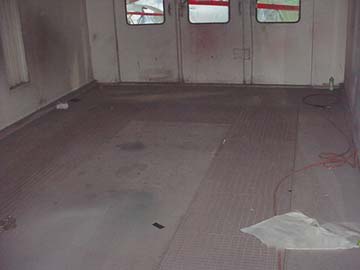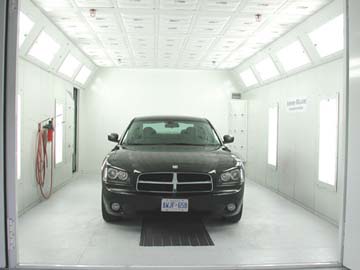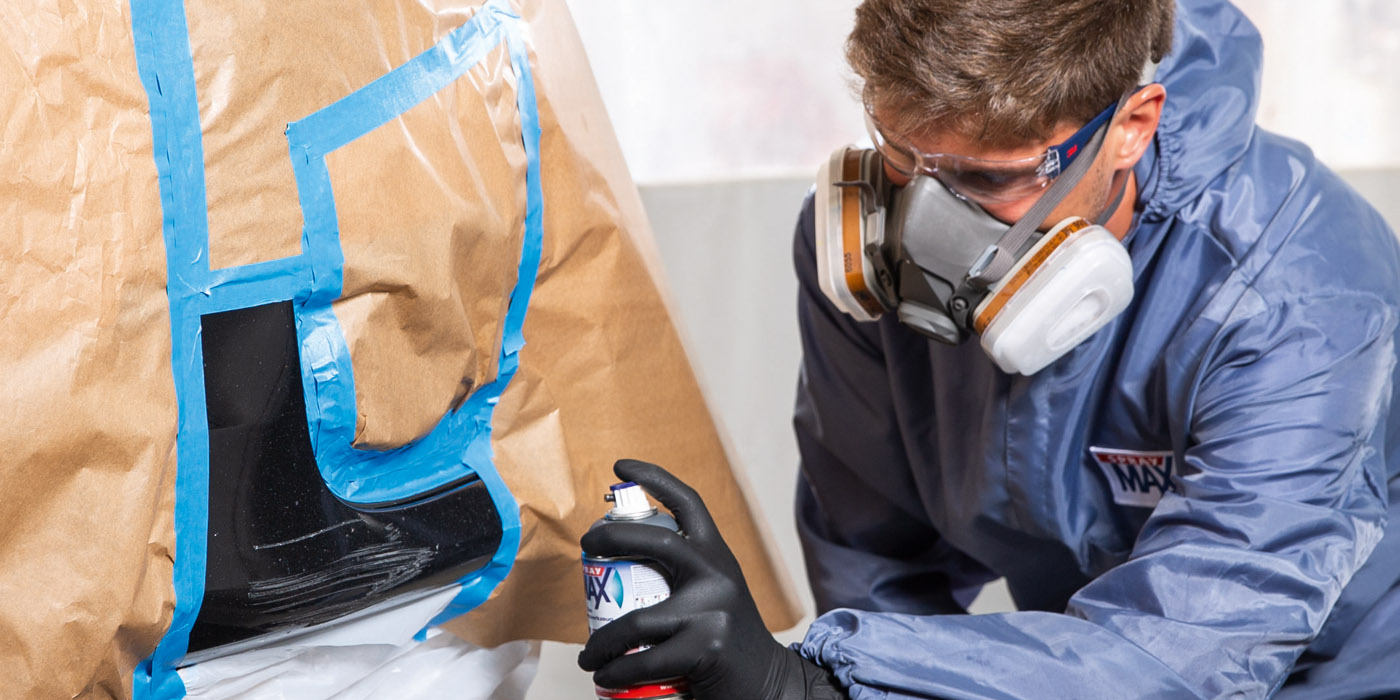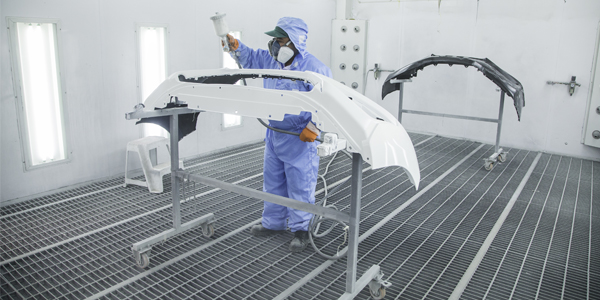

Let’s face it, we’ve all had to cut and buff paint because of imperfections and trash. I remember when I started out in this business more than 20 years ago, acrylic lacquer was the paint of choice. I’m sure a lot of us remember those days, doing combo work and painting in an open shop with no booth while the guy in the next stall was sanding Bondo. We had to wet sand and buff everything. Those were the days, huh?
In one way, this business as a whole has advanced far beyond those days. Some of the progress was imposed on us by stiffer laws and regulations pertaining to the environment and safety. Along with these changes came an improvement in the material we were using. But because the material we use today is designed to be harder and more durable, it’s also much more difficult to cut and buff compared to the lacquer we used in the past – not to mention it’s designed by the manufacturers to have a factory look and shine without buffing. So why wouldn’t we want to do everything possible to take advantage of the higher quality of today’s modern materials to maximize profit?
A Bad Situation
First of all, let me tell you about a shop I worked at for eight years before recently leaving. We had two old negative pressure crossdraft paint booths, which were situated in front of a gravel and dirt parking lot. The air intake was in the doors, which were about three feet from the gravel parking lot, and we had to cut and buff everything. It seemed no matter how clean I kept the inside of the booths, the car to be painted and myself, I still had a problem with trash. Fortunately, I had an excellent prepper who actually enjoyed cutting and buffing. But I still had to listen to innuendos from my boss about trash and what it cost him to have my prepper cut and buff everything. For years, I believed it was a shortcoming on my part. I couldn’t see what I was doing wrong or how to fix it, but the guilt I felt due to my boss’s remarks caused me to do some figuring on my own.
The first thing I thought of was the fact that I gave up a large enough portion of my 40 percent commission to pay my prepper’s salary. So how was it costing my boss money? In actuality, it was costing me money.
The word “prep” or “prepper” comes from the word prepare, which is defined in the Webster’s Dictionary as follows: “To make ready; to adjust; to provide; to procure as suitable.” Have you ever seen a “prep” game show after a football game? Of course not, it’s the “postgame” show. So if the person prepping the car is also the person who takes care of cutting and buffing, than he’s not just a “prepper” but a “post-er!” So how on earth is it a prepper’s job to cut and buff? In addition, my prepper was responsible for featheredging, priming and blocking (another procedure not on an estimate), but I was still paying him from my cut of commission. By my calculations, my prepper spent 30 to 40 percent of his time on procedures that were not on the estimate. So I was paying for him to do procedures I wasn’t even getting paid to do.
I know what some of you are thinking. It should be the painter’s job to cut and buff, right? However, as a commissioned painter, I get paid to do what’s on the estimate. Let’s remember what the Mitchell Collision Guide procedure or P-pages clearly says:
Finish, sand and buff outside surface area (s): Allow .3 per refinish hour (30%) to finish, sand and buff each surface area(s).
So cutting and buffing isn’t included in paint time! (For that matter, neither is featheredge, prime and block time. But trust me, that’s a whole other article.)
Now don’t get me wrong, I’m not saying if I get a big piece of trash or a sag I shouldn’t buff it. Of course it needs to be removed, but if it’s standard operating procedure to cut and buff everything because of poor shop equipment, why should an owner’s refusal to upgrade his equipment cost a commission tech money? At the very least, the owner should pay out of his or her pocket for a detailer to perform this procedure.
What It Costs
OK, so now I have to ask, why wouldn’t an owner upgrade his equipment? Obviously because they think it’s too costly. First, let’s get an idea of what it would cost. After calling several places I found on the Internet where you can buy paint booths, I came up with a basic average cost. Remember, booths can come with a variety of options, depending on the needs of your particular shop and the amount you can afford or are willing to pay:
- Basic booth: $13,500 (This is just an unpainted shell with no windows in the doors.)
- Booth with windows and powder coated walls: $16,000 to $18,000
- Ramps and basement: $11,000 (This option can be used in place of digging a pit which is sometimes desired if you lease your building or may be planning on moving your booth in the future.)
- If a pit in the floor is the option you choose, it can cost $8,000 to $10,000.
- To add heat to your booth if baking is desired, the furnace addition can cost $8,000 to $12,000.
OK, so those are just averages. I know I’ll probably get e-mails from a lot of owners saying, “What the heck? I paid a lot more than that for my booth!” Again, these are just the averages that I acquired from various sources.
So, even at the high-ends of my averages, it would pretty much go like this:
- Booth powder coated, with windows: $18,000
- Ramps, and basement (more expensive, less evasive): $11,000
- Furnace giving the option to bake: $12,000
- Total: $41,000 (Plus shipping and handling. Let’s assume that cost is $9,000, which is a very high estimate for shipping.)
- Grand total: $50,000
I agree that $50,000 is a large investment, but we now have to calculate what it costs to have to cut and buff everything. So here I go again with numbers (pretty good for a painter though, huh?)
Let’s say your paint shop averages 100 hours a week, but you have to cut and buff everything. At .3 per paint hour to cut and buff as listed in the P-pages, you’ll be performing 33.3 hours of legitimate and billable paint labor for free, unless you’re one of the lucky ones who can actually justify this process to the insurance companies and get paid for it. (If you’re one of those fortunate ones, you may stop reading now if you wish, but keep in mind that time spent on this procedure can take away from other production.)
OK, you’re still reading? Good!
The 33.3 hours of labor at the current rate in my area of $44 per hour for paint labor adds up to $1,465.20 per week. At 40 percent commission, the technician would lose $586.08 per week and the shop would lose $879.12 per week.
When we multiply those numbers by 52, we get an annual loss average for the shop and painter.
- Shop loss per year = $45,724.24
- Paint shop or tech loses = $30,476.16
- Total annual loss = $76,190.40
That in itself would pay for a new booth, but let’s press on. We now have to calculate the loss on materials. The shop I’m at gets $30 per paint hour for paint and materials. So now if we multiply 33.3 hours per week by $30 per paint hour for paint and materials, we get an additional loss of $999 per week. When we multiply that by 52 weeks, we get $51,948 lost in paint and materials per year.
I could go on further by stating the fact that most technicians are 200 percent efficient, which means they perform two hours of labor for every hour they’re at work. So if the paint shop wasn’t performing the cut and buff task, the tech could be onto another new job and increase production. But I don’t think I need to go on with my calculations to further prove my point. I will say this, though: the shop I’m currently at has downdraft booths instead of the crossflow booths my previous shop had, and I went from a paint shop that averaged 100 hours per week to one that averaged 160 per week. You do the math because I’ve got a headache from all the calculations I’ve done already. But here are the basic numbers we’ve discussed.
- Labor loss to cut and buff for shop: $45,724.24
- Labor loss to technicians to cut and buff: $30.476.16
- Paint and material loss to cut and buff: $51,948
- Total losses excluding loss of production: $128,148.40
- Cost of new booth: $50,000
- Annual profit you could receive in the first year after replacing your old booth: $78,148.40
Now I know some of you guys are thinking, “Is this guy a booth salesman?” Well, I’m not. I’m just a painter who worked for years in a shop with old crossdraft negative pressure booths and was lucky enough to upgrade his situation by changing to a shop with downdraft booths. And I’m here to tell you it makes a huge difference in my personal profit and the owners’ profit.
I know a lot of you guys may be skeptical, but I urge you to calculate your shop’s numbers yourself. You’ll be very surprised at what you discover.
Writer Frank Hauf began his career in the auto body industry in a combo shop more than 20 years ago in Chicago. For the last eight years, he’s been living on the Alabama Gulf Coast and working as a painter.













